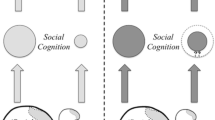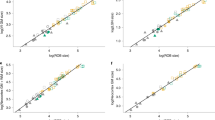Abstract
Evolutionary transitions in social behavior are often associated with changes in species’ brain architecture. A recent comparative analysis showed that the structure of brains of wasps in the family Vespidae differed between solitary and social species: the mushroom bodies, a major integrative brain region, were larger relative to brain size in the solitary species. However, the earlier study did not account for body size effects, and species’ relative mushroom body size increases with body size in social Vespidae. Here we extend the previous analysis by measuring the effects of body size variation on brain structure differences between social and solitary vespid wasps. We asked whether total brain volume was greater relative to body size in the solitary species, and whether relative mushroom body size was greater in solitary species, after accounting for body size effects. Both total brain volume and relative mushroom body volume were significantly greater in the solitary species after accounting for body size differences. Therefore, body size allometry did not explain the solitary versus social species differences in brain structure. The evolutionary transition from solitary to social behavior in Vespidae was accompanied by decreases in total brain size and in relative mushroom body size.



Similar content being viewed by others
References
Bergman TJ, Beehner JC (2015) Measuring social complexity. Anim Behav 103:203–209
Bshary R, Gingins S, Vail AL (2014) Social cognition in fishes. Trends Cogn Sci 18:465–471
Burish MJ, Kueh HY, Wang SSH (2004) Brain architecture and social complexity in modern and ancient birds. Brain Behav Evol 63:107–124
Danforth BN (2002) Evolution of sociality in a primitively eusocial lineage of bees. Proc Natl Acad Sci 99:286–290
DeCasien AR, Williams SA, Higham JP (2017) Primate brain size is predicted by diet but not sociality. Nat Ecol Evol 1:0112
Dunbar RI, Shultz S (2007) Evolution in the social brain. Science 317:1344–1347
Fahrbach SE (2006) Structure of the mushroom bodies of the insect brain. Annu Rev Entomol 51:209–232
Farris SM (2016) Insect societies and the social brain. Curr Opin Insect Sci 15:1–8
Farris SM, Van Dyke JW (2015) Evolution and function of the insect mushroom bodies: contributions from comparative and model systems studies. Curr Opin Insect Sci 12:19–25
Farris SM, Robinson GE, Fahrbach SE (2001) Experience- and age-related outgrowth of intrinsic neurons in the mushroom bodies of the adult worker honeybee. J Neurosci 21:6395–6404
Finlay BL, Darlington RB, Nicastro N (2001) Developmental structure in brain evolution. Behav Brain Sci 24:263–278
Gronenberg W, Riveros AJ (2009) Social brains and behavior—past and present. In: Gadau J, Fewell J (eds) Organization of insect societies: from genome to sociocomplexity. Harvard University Press, Cambridge, pp 377–401
Hager R, Lu L, Rosen GD, Williams RW (2012) Genetic architecture supports mosaic brain evolution and independent brain–body size regulation. Nat Commun 3:1079
Hines HM, Hunt JH, O’Connor TK, Gillespie JJ, Cameron SA (2007) Multigene phylogeny reveals eusociality evolved twice in vespid wasps. Proc Natl Acad Sci 104:3295–3299
Isler K, Van Schaik CP (2006) Metabolic costs of brain size evolution. Biol Lett 2:557–560
Isler K, Van Schaik CP (2009) The expensive brain: a framework for explaining evolutionary changes in brain size. J Hum Evol 57:392–400
Jones TA, Donlan NA, O’Donnell S (2009) Growth and pruning of mushroom body Kenyon cell dendrites during worker behavioral development in the paper wasp, Polybia aequatorialis (Hymenoptera: Vespidae). Neurobiol Learn Mem 92:485–495
Keating-Godfrey R, Wulfila Gronenberg W (2019) Brain evolution in social insects: advocating for the comparative approach. J Comp Physiol A 205:13–32
Kotrschal A, Rogell B, Bundsen A, Svensson B, Zajitschek S, Brännström I, Immler S, Maklakov AA, Kolm N (2013) Artificial selection on relative brain size in the guppy reveals costs and benefits of evolving a larger brain. Curr Biol 23:168–171
Kverková K, Bělíková T, Olkowicz S, Pavelková Z, O’Riain MJ, Šumbera R, Burda H, Bennett NC, Němec P (2018) Sociality does not drive the evolution of large brains in eusocial African mole-rats. Sci Rep 8:9203
Lihoreau M, Latty T, Chittka L (2012) An exploration of the social brain hypothesis in insects. Front Physiol 3:442
Niven JE, Laughlin SB (2008) Energy limitation as a selective pressure on the evolution of sensory systems. J Exp Biol 211:1792–1804
O’Donnell S, Bulova SJ (2017) Development and evolution of brain allometry in wasps (Vespidae): size, ecology and sociality. Curr Opin Insect Sci 22:54–61
O’Donnell S, Bulova SJ, DeLeon S, Khodak P, Miller S, Sulger E (2015) Distributed cognition and social brains: reductions in mushroom body investment accompanied the origins of sociality in wasps (Hymenoptera: Vespidae). Proc R Soc B 282:20150791
O’Donnell S, Bulova SJ, Barrett M, Fiocca K (2018) Size constraints and sensory adaptations affect mosaic brain evolution (paper wasps—Vespidae: Epiponini). Biol J Linn Soc 123:302–310
Perez-Barberıa FJ, Shultz S, Dunbar RIM (2007) Evidence for coevolution of sociality and relative brain size in three orders of mammals. Evolution 61:2811–2821
Piekarski PK, Carpenter JM, Lemmon AR, Moriarty Lemmon E, Sharanowski BJ, Crandall K (2018) Phylogenomic evidence overturns current conceptions of social evolution in wasps (Vespidae). Mol Biol Evol 35:2097–2109
Reader SM, Laland KN (2002) Social intelligence, innovation, and enhanced brain size in primates. Proc Natl Acad Sci 99:4436–4441
Turillazzi S (2012) The biology of hover wasps. Springer, Berlin
Webb CO, Ackerly DD, Kembel SW (2008) Phylocom: software for the analysis of phylogenetic community structure and character evolution. Bioinformatics 24:2098–2100
West RJ (2014) The evolution of large brain size in birds is related to social, not genetic, monogamy. Biol J Linn Soc 111:668–678
West-Eberhard MJ (2005) Behavior of the primitively social wasp Montezumia cortesioides Willink (Vespidae Eumeninae) and the origins of vespid sociality. Ethol Ecol Evol 17:201–215
Wilson EO, Hölldobler B (2005) Eusociality: origin and consequences. Proc Natl Acad Sci 102:13367–13371
Zars T (2000) Behavioral functions of the insect mushroom bodies. Curr Opin Neurobiol 10:790–795
Acknowledgements
Research was funded by NSF Grant 1209072, a Wistar Morris grant, and the College of Arts and Sciences of Drexel University (to S. O’D.).
Author information
Authors and Affiliations
Corresponding author
Ethics declarations
Conflict of interest
The authors declare that they have no conflict of interest.
Additional information
Publisher's Note
Springer Nature remains neutral with regard to jurisdictional claims in published maps and institutional affiliations.
Electronic supplementary material
Below is the link to the electronic supplementary material.
Rights and permissions
About this article
Cite this article
O’Donnell, S., Bulova, S., DeLeon, S. et al. Brain structure differences between solitary and social wasp species are independent of body size allometry. J Comp Physiol A 205, 911–916 (2019). https://doi.org/10.1007/s00359-019-01374-w
Received:
Revised:
Accepted:
Published:
Issue Date:
DOI: https://doi.org/10.1007/s00359-019-01374-w




